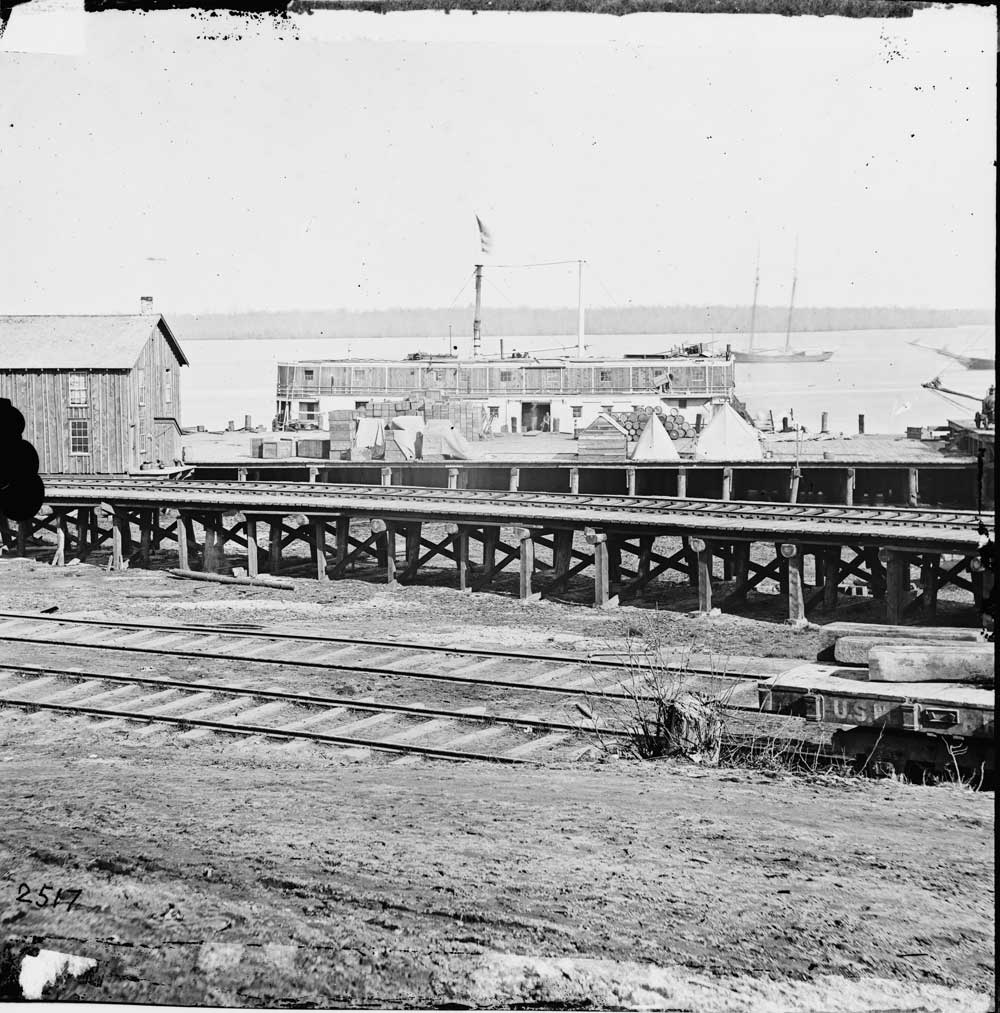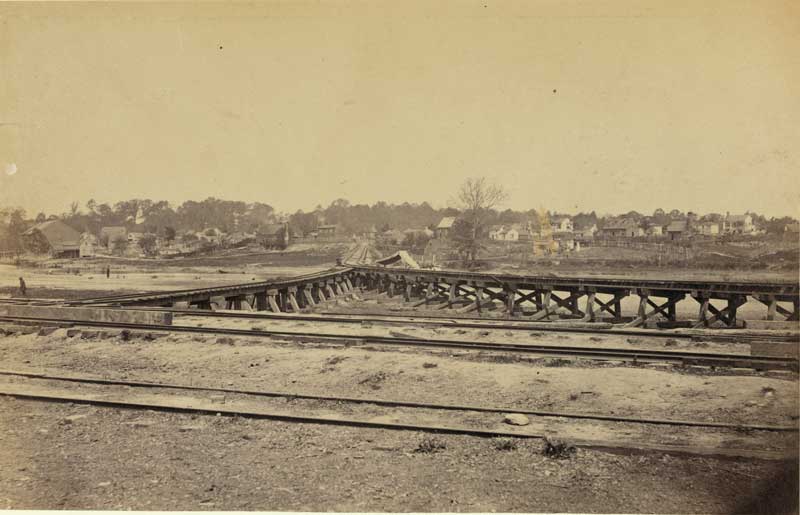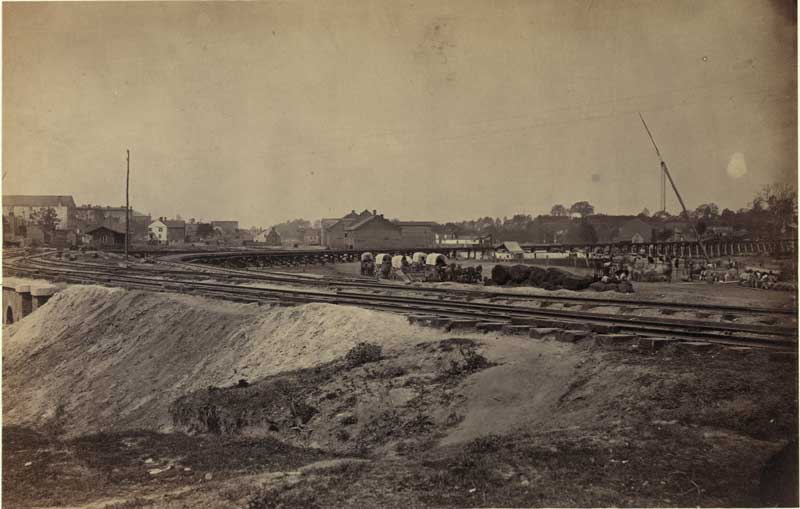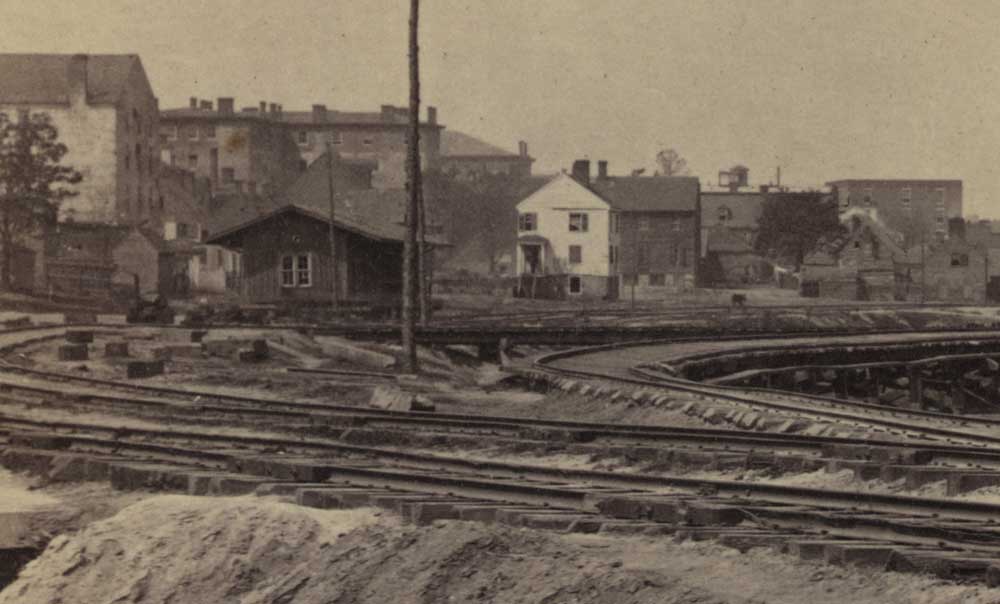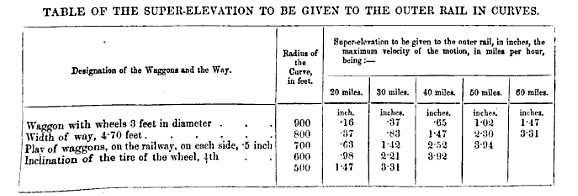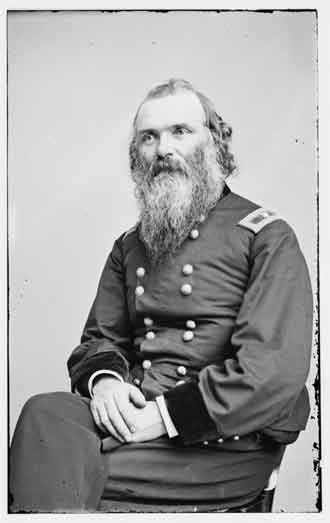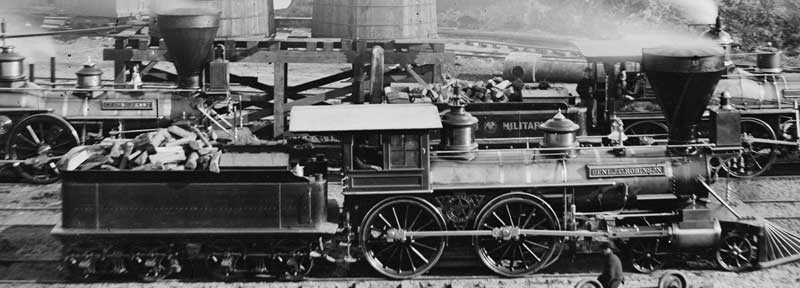
That said, so far I have been able to document 21 locomotives that have been on the line at one time or another through either pictures found at various online archives, websites, interest groups, as well as the wonderful timetable for March 19th, 1865 that Bernard Kempinski has added to his blog. I have put online an animated map of the "City Point and Army Line" showing the hour by hour movement of trains for this timetable. Hopefully Bernard can find time to put up more timetables in order to firm up the locomotive list a bit more.
There is a report on all locomotives of the USMRR in the file section of othe Civil War railroad yahoo group message board by Richard M. Hochadel, that is a great resource for USMRR locomotives. That report is where much of this information comes from.| source | locomotive | type | comments (most from yahoo group report) |
| photo only - timeframe to be researched |
|||
| photo | Governor Nye | Norris 4-4-0 | 1864.04-07 Repaired Alexandria 1865.05.02 Transferred to become USMRR Dept. of North Carolina #16 |
| photo | Col Beckwith | Norris 4-4-0 | 1864.04-07 Repaired at Alexandria. 1865.10 Sold to the Baltimore & Ohio |
| evidence for 1864 only | |||
| photo - fall 1864 | President (2nd) | Eastwick & Harrison 4-4-0 | captured by USA on the
W&P in 1862 repaired Alexandria 1864-06 |
| Yahoo Group Report | Indiana | Baldwin 0-8-0 | 1863.06-11 Repaired at Alexandria. 1864 Used on the City Point & Army Line 1864.07 Sold to J. Cooper for $1,675 |
| Yahoo Group Report | Monitor | Souther 4-4-0 | 1864.04-07 Repaired at Alexandria 1864 Used on the City Point & Army Line 1865 Used on the Winchester & Potomac |
| Yahoo Group Report | E.M. Stanton | Norris 4-6-0 | 1862-1863 Used on Orange & Alexandria and construction 1864 Used on City Point & Army Line 1865 Used on O&A and construction |
| evidence for 1864-1865 |
|||
| Yahoo Group Report/timetable | Pickwick | Norris 4-4-0 | 1863 Used on the Orange & Alexandria and construction 1864.04-07 Repaired Alexandria 1864 Used on the City Point & Army Line 1865 Used on the O&A and construction. |
| Yahoo Group Report/photo | Lieut. General Grant | Rogers 4-4-0 | 1864.05 At White House 1864.06.16 Returned to Alexandria 1864-1865 Used on the Winchester & Potomac and the City Point and Army Line |
| Yahoo Group Report/photo/timetable | General Dix | Baldwin 4-4-0 | 1864 Used on the O&A and the Winchester & Potomac 1864-1865 City Point |
| Yahoo Group Report/timetable | C. Vibbard | Baldwin 4-4-0 | 1864.03 Plunged into the Potomac River through the draw in
the Long Bridge connecting Alexandria and Washington, DC. 1864 Used on the City Point & Army Line 1865 Used on the Norfolk & Petersburg and the Seaboard & Roanoke |
| Yahoo Group Report/timetable | Geo. A. Parker | Baldwin 4-4-0 | 1863 Used on the O&A 1864-1865 Used on the City Point & Army Line |
| Yahoo Group Report | General McCallum | New Jersey 4-4-0 | 1862-1863 Used on the Orange & Alexandria and
construction 1864-1865 Used on the City Point & Army Line. |
| Yahoo Group Report/timetable | May Queen | Norris 4-4-0 | 1863 Used on the Orange & Alexandria and RF&P 1864-1865 Used on the City Point & Army Line |
| evidence for 1865 only |
|||
| timetable | Tiger | New Jersey 4-4-0 | 1864.04-07 Repaired at Alexandria 1864-1865 Used on the O&A and construction |
| Yahoo Group Report | Humming Bird | Baldwin 4-4-0 | 1864.04-07 Repaired at Alexandria 1863-1864 Used on the O&A and construction 1865 Used on the City Point & Army Line |
| Yahoo Group Report/photo | General Robinson | Mason 4-4-0 | 1864.04-06.16 At Aquia Creek 1865 Used on City Point & Army Line |
| Yahoo Group Report/timetable | Fire Fly | Norris 4-4-0 | 1863-1864 Used on the O&A 1865 Used on City Point & Army Line |
| Yahoo Group Report | H.L. Robinson | Mason 4-4-0 | 1863 Used on the O&A and construction 1864 Used on the Norfolk & Petersburg and the Seaboard & Roanake 1865 Used on the City Point & Army Line |
| Yahoo Group Report | Hiawatha | Norris 4-4-0 | 1863-1864 Used on the Orange & Alexandria
and RF&P 1865 Used on the City Point & Army Line |
| Cars | purchased | built | captured | total added | lost/destroyed | sold cash | sold exec. order | returned | total reduced | change | year end |
| 1862 | 503 | 13 | 516 | 458 | 458 | 58 | 58 | ||||
| 1863 | 704 | 30 | 734 | 15 | 10 | 25 | 709 | 767 | |||
| 1864 | 68 | 68 | 57 | 126 | 183 | -115 | 652 | ||||
| 1865 | 415 | 415 | 20 | 958 | 38 | 13 | 1029 | -614 | 38 | ||
| 1866 | 38 | 38 | -38 | 0 |
| type | virgina total value | city point value | percent city point | percent type in VA. | approx number in VA. | city point estimate |
| box car | 393750 | 44100 | 11 | 58 | 407 | 45 |
| flat car | 210800 | 27200 | 13 | 31 | 217 | 28 |
| stock car | 26100 | 1800 | 7 | 4 | 27 | 2 |
| passenger car | 47000 | 11750 | 25 | 7 | 49 | 12 |
| total | 677650 | 84850 | 13 |
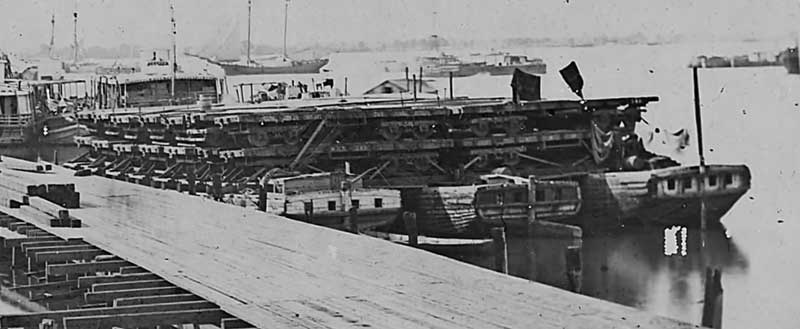
This is the start of a section detail interesting track details
that will need to be modeled. It may eventually migrate to a
separate page.
In the following picture of a part of the City Point Wharf, I
noticed that the track on the trestle appears to be
super-elevated. Super-elevation is when the outside rail of
a curve is higher than the inside rail in order to counteract
centripetal force. This allows trains to travel safely at a
faster speed around relatively tight bends.
